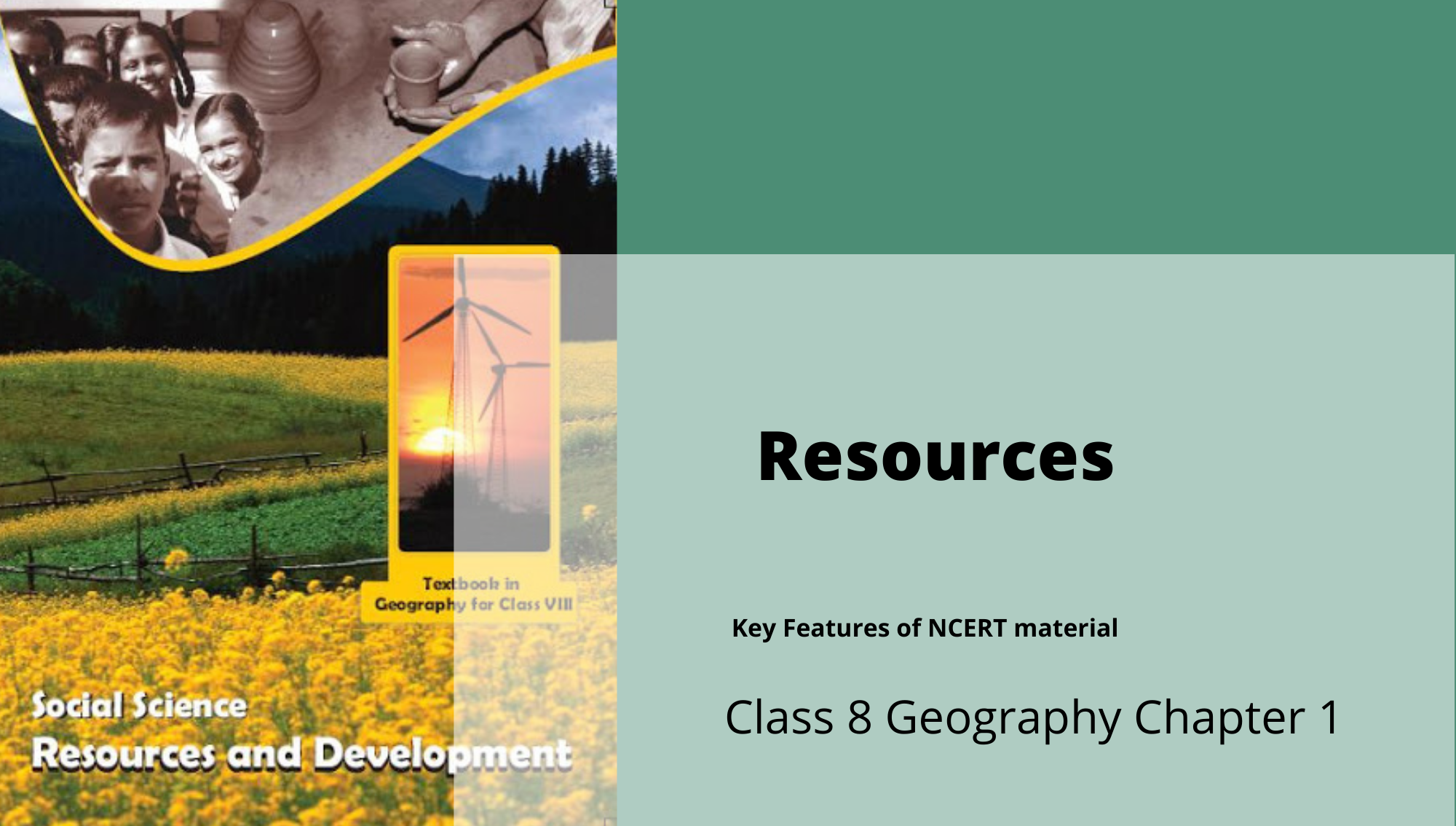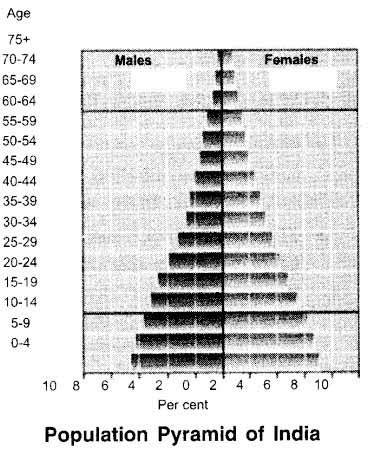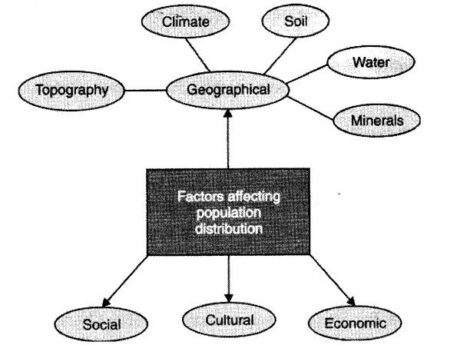Resources: Geography Class 8 Chapter-1

Key Features of NCERT Material for Class 8 Geography Chapter 1 – Resources
Quick revision notes
In chapter 1: Resources, you will learn about the various forms of resources and the forms of different resources
Resources
Anything that can be used to satisfy a need or has value can be called a resource. Water, electricity, rickshaw, vegetable and textbook all have utility and hence are considered as resources. All the resources have value or worth. Some resources have economic value, some do not. Some may become valuable only over a period of time. For example, your grandmom’s home remedies may not have commercial value at present but if they are patented and sold, they could also become economically valuable. Meanwhile, the two factors that change substances to resources include time and technology.
Types of Resources
Resources are of 3 kinds- natural, human made and human.
Natural Resources are drawn from nature and are used without much modification. Examples include the air we breathe, water in our rivers and lakes, soil, minerals and so on. Natural resources can also be categorised into renewable and non-renewable resources. Renewable resources can be renewed and get replenished very quickly. Solar and wind energy are renewable resources that are unlimited and will not be affected by human activities.
Human Made Resources: At times, natural substances become resources only after their original form has changed. People make use of natural resources to manufacture human made resources like buildings, bridges, roads, machinery and vehicles. Another example is technology.
Human Resource refers to the number (quantity) and abilities (mental and physical) of the people. That is why human beings are a special resource. People are human resources. Improving the quality of people’s skills so that they are able to create more resources is known as human resource development.
People are a country’s most noteworthy asset. It is their capacity and information which transforms them into the asset.
The manner by which people are spread over the world’s surface is known as an example of Population dissemination.
Almost 90 percent of the total Population lives in about 10% of the land surface.
High height territories, tropical deserts, high mountains and regions of central timberlands are inadequately populated. Though South and Southeast Asia, Europe and northeastern North America are thickly populated.
The quantity of people living in a unit territory of the world’s surface is called thickness of Population.
Geology, atmosphere, soil, water, minerals, social, social and financial conditions are the significant elements that influence the dissemination of the Population.
Change in the quantity of people during a particular time is known as Population change. The significant reasons for Population change are birth rate, demise rate, and relocation.
The distinction between the birth rate and passing rate is known as the development pace of the Population.
Pace of Population development shifts over the world.
Population organization alludes to the structure of the Population. From Population piece, we mean the quantity of guys and females, age bunch they have a place with, training level, word related conveyance, salary level, societal position, and so forth.
A Population pyramid, likewise called the age and sex pyramid, causes us to comprehend the organization of Population in any nation.
People are the most significant asset of a country. They are huge on the grounds that had they not used their minds, different assets of nature would not have discovered any utility. As such, human asset is a definitive asset.
The manner by which people are spread over the world’s surface is known as the example of Population conveyance. A few regions are packed (high thickness) while some are less packed (low thickness). Population thickness relies upon the atmosphere conditions and geography of the spot, similar to barely any people live in high scope regions, tropical deserts, hilly landscapes, and woods territories, though an enormous number of people live in fields.
The thickness of Population is characterized as the normal number of people living in a unit territory of the world’s surface. The thickness of a specific district is determined by partitioning the number of inhabitants in the locale by its region.
Geography, great atmosphere, ripeness of soils, accessibility of new water, minerals are major topographical elements influencing Population thickness of an area. People want to live on fields more than mountains or levels and they live more in moderate atmospheres than extraordinary hot or cold. From the farming perspective, ripe terrains are liked. Zones with mineral stores are more populated.
Some social factors that support the thickness of Population in an area are better lodging, instruction and wellbeing offices.
Spots with social or chronicled criticalness are normally populated.
Work openings are another fascination for huge lumps of Population.
The term Population change alludes to change in the Population regarding time. The number of inhabitants on the planet is rarely steady; the quantity of births and passings influence its change.
With better wellbeing offices because of advancement in clinical science, presently the quantity of passings is lower than previously.
Birth rate is a measurement that quantifies the quantity of live births per 1000 people. Demise rate is a measurement that gauges the quantity of passings per 1000 people.
At the point when we discussion of the number of inhabitants in a specific area, nation or mainland, and not the entire world, at that point alongside birth and demise rate, another factor influencing Population change is movement. Relocation alludes to the development of people starting with one territory then onto the next.
Since births and passings are characteristic reasons for Population change, the distinction between the birth and demise rate is known as the normal passing rate.
People leaving a nation are called migrants and the wonder is called displacement. People showing up in a country’are called migrants and the marvel is called movement. People for the most part relocate from less created territories to more created ones, in look for better business openings, among different offices.
The example of Population change is diverse for various pieces of the world.
The structure of the Population with different regards Age like age, sex, education, occupations, wellbeing offices, 75+ financial condition, and so forth is called Population creation.
A Population pyramid is a pictorial method to portray 55-59 the Population organization. An age-sex pyramid of India is appeared in the figure.

The state of Population pyramid of a nation is demonstrative of a great deal of data about the nation.
The size towards the base might be utilized to 20-24 gauge the birth rate, while the size towards the top to appraise the passing rate.
The youths (ages 0-15) and senior residents (matured 65 above) are said to fall under the “needy” gathering.
They are viewed as financially idle; they rely upon the common laborers for their living. The middle age bunch establishes the common laborers.
A Population pyramid in which the base is wide and the top part is tight implies that albeit a lot of births happen, not all grow up to be grown-ups and old; it implies many kick the bucket before arriving at these ages. This demonstrates a huge demise rate and Kenya shows such a pyramid. This implies a high Population development rate.
In nations like India, the passing rate is diminishing, so the pyramid is wide in the more youthful age gatherings, and the size of the pyramid diminishes consistently.
Flow learning:

Human Resource: Human creatures who are sound, instructed, and intellectually solid can end up being valuable for a nation or network and are treated as assets themselves, called HR.
Population: The absolute number of people living in a specific locale is supposed to be the number of inhabitants in that specific area.
The example of Population Distribution: The manner by which people are spread over the world’s surface is known as the example of Population appropriation.
Population Density: The normal number of people living in a unit zone of a specific district, determined by isolating the all out Population of the locale by the all out zone of that area, is known as the Population thickness of that locale.
Population Change: The adjustment in the Population, when portrayed over a specific time allotment, is called Population change.
Birth Rate: Birth rate is a measurement that quantifies the quantity of live births per 1000 people.
Passing Rate: Death rate is a measurement that gauges the quantity of passings per 1000 people.
Future: Life anticipation is the quantity of years that a normal individual can hope to live, determined by existing information for the specific district.
Relocation: Migration alludes to the development of people starting with one territory then onto the next.
Normal Death Rate: The distinction between the birth and demise rate is known as a characteristic passing rate.
Migrants/Emigration: People leaving a nation are called wanderers and the wonder is called displacement.
Foreigners/Immigration: People showing up in a nation are called migrants and the marvel is called movement.
Population Composition: The structure of the Population with different regards like age, sex, proficiency, occupations, wellbeing offices, monetary condition, and so forth is called Population sythesis.
Population Pyramid: A Population pyramid is a pictorial method to portray the Population piece.

